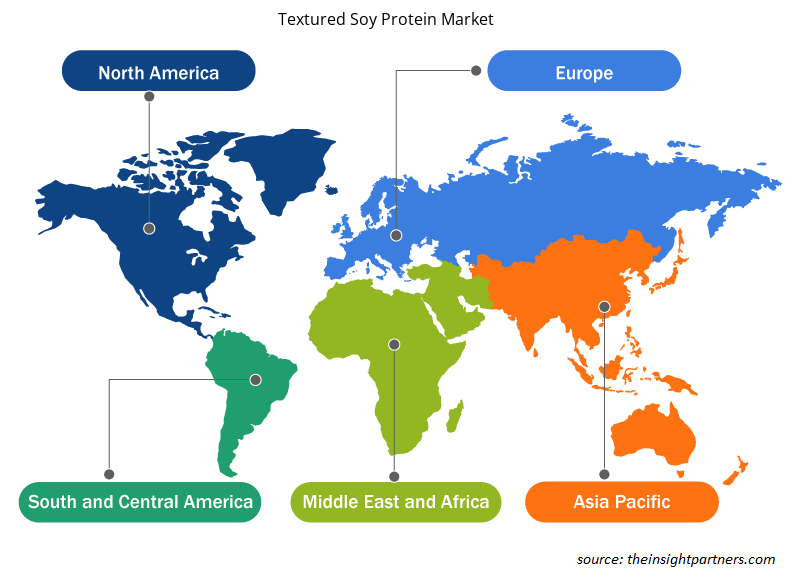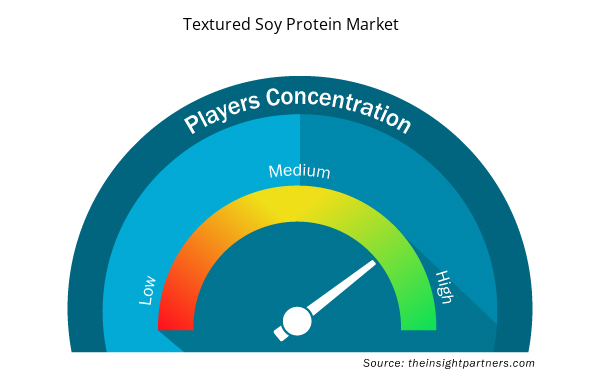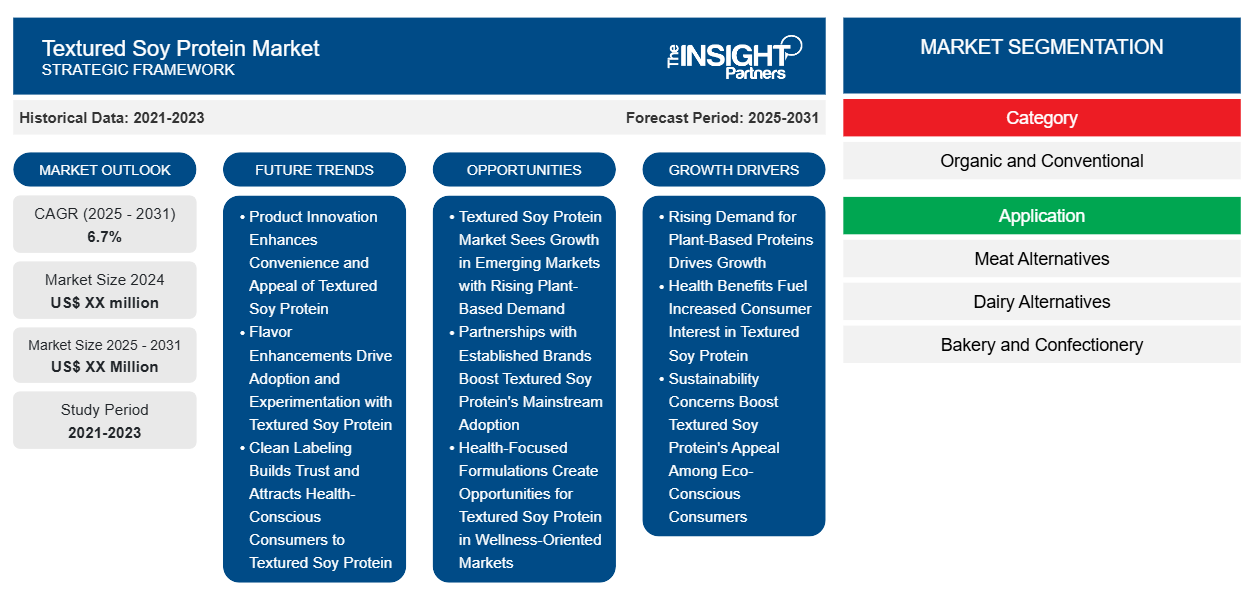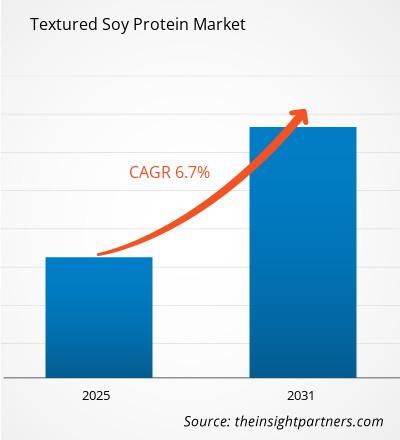Si prevede che il mercato delle proteine di soia testurizzate registrerà un CAGR del 6,7% dal 2024 al 2031, con una dimensione di mercato in espansione da XX milioni di dollari nel 2024 a XX milioni di dollari entro il 2031.
Il report è suddiviso per categoria (biologico e convenzionale). Il report presenta inoltre un'analisi basata sull'applicazione (alternative alla carne, alternative ai latticini, prodotti da forno e dolciumi, snack dolci e salati, nutrizione infantile e altri). L'ambito del report copre cinque regioni: Nord America, Europa, Asia Pacifico, Medio Oriente e Africa, e Sud e Centro America e paesi chiave in ciascuna regione. L'analisi globale è ulteriormente suddivisa a livello regionale e nei principali paesi. Il report offre il valore in USD per l'analisi e i segmenti di cui sopra.
Scopo del rapporto
Il report Textured Soy Protein Market di The Insight Partners mira a descrivere il panorama attuale e la crescita futura, i principali fattori trainanti, le sfide e le opportunità. Ciò fornirà spunti a vari stakeholder aziendali, come:
- Fornitori/produttori di tecnologia: per comprendere le dinamiche di mercato in evoluzione e conoscere le potenziali opportunità di crescita, consentendo loro di prendere decisioni strategiche informate.
- Investitori: condurre un'analisi completa delle tendenze in merito al tasso di crescita del mercato, alle proiezioni finanziarie del mercato e alle opportunità esistenti lungo la catena del valore.
- Enti di regolamentazione: regolamentano le politiche e le attività di controllo sul mercato allo scopo di ridurre al minimo gli abusi, preservare la fiducia degli investitori e sostenere l'integrità e la stabilità del mercato.
Segmentazione del mercato delle proteine di soia testurizzate
Categoria
- Biologico e convenzionale
Applicazione
- Alternative alla carne
- Alternative ai latticini
- Panetteria e pasticceria
- Snack dolci e salati
- Nutrizione infantile
- Altri
Personalizza questo report in base alle tue esigenze
Riceverai la personalizzazione gratuita di qualsiasi report, comprese parti di questo report, o analisi a livello nazionale, pacchetto dati Excel, oltre a usufruire di grandi offerte e sconti per start-up e università
- Scopri le principali tendenze di mercato in questo rapporto.Questo campione GRATUITO includerà analisi di dati che spaziano dalle tendenze di mercato alle stime e alle previsioni.
Fattori di crescita del mercato delle proteine di soia testurizzate
- La crescente domanda di proteine vegetali stimola la crescita: il mercato delle proteine di soia testurizzate è fortemente alimentato dalla crescente domanda di proteine vegetali. I consumatori stanno diventando sempre più vegetariani e vegani e, pertanto, hanno bisogno di alternative alla carne arricchite di nutrienti. La comodità con l'aspetto e la sensazione, come la capacità di assomigliare alle consistenze e al sapore della carne, è una delle principali attrazioni delle proteine di soia testurizzate.fuelled by the increasing demand for plant-based proteins. Consumers are becoming increasingly vegetarians and vegans and, therefore, need nutrient-enriched meat alternatives. Comfort with the look and feel, such as the ability to resemble meat textures and flavor, is one of the primary attractions of textured soy protein.
- I benefici per la salute alimentano un crescente interesse dei consumatori per le proteine di soia testurizzate: le proteine di soia testurizzate stanno assistendo a una crescita di mercato crescente perché i consumatori stanno diventando più consapevoli del loro valore nutrizionale. Ricche di proteine, fibre e aminoacidi essenziali, le proteine di soia testurizzate nutrono i muscoli e il benessere generale. Povere di grassi e con nutrienti benefici, i consumatori attenti alla salute vogliono più proteine di soia testurizzate aggiunte a pasti e spuntini.
- Le preoccupazioni sulla sostenibilità aumentano l'attrattiva delle proteine di soia testurizzate tra i consumatori attenti all'ambiente: un'altra preoccupazione che guida il mercato delle proteine di soia testurizzate è quella sulla sostenibilità. Le persone stanno optando per alimenti molto più ecologici e le proteine di soia testurizzate hanno un'impronta di carbonio inferiore e richiedono meno risorse rispetto alle proteine animali. Le preoccupazioni sulla sostenibilità a livello di consumatore non sono vane, poiché il crescente interesse dei consumatori per le diete sostenibili porterà a una maggiore domanda di proteine di soia testurizzate poiché i consumatori attenti all'ambiente ne saranno entusiasti.
Tendenze future del mercato delle proteine di soia testurizzate
- L'innovazione di prodotto migliora la praticità e l'attrattiva delle proteine di soia testurizzate: le innovazioni nei prodotti sono cambiamenti che avvengono nel mercato delle proteine di soia testurizzate e un player propone offerte variegate di pasti pronti da mangiare, snack e sostituti della carne. Queste innovazioni soddisfano preferenze diverse e si aggiungono alle esigenze dietetiche dei consumatori, migliorano la praticità e attraggono coloro che cercano opzioni vegetali nutrienti e adatte agli stili di vita moderni.
- I miglioramenti del sapore stimolano l'adozione e la sperimentazione con le proteine di soia testurizzate: il miglioramento del sapore è una tendenza in rapida ascesa nelle proteine di soia testurizzate. In questa categoria, i marchi stanno sperimentando spezie, marinate e condimenti audaci per ottenere i prodotti più super deliziosi e versatili in circolazione. Il sapore delle proteine di soia testurizzate le rende molto attraenti per i consumatori, il che è un promotore di una maggiore adozione e di una maggiore sperimentazione nella cucina casalinga.
- L'etichettatura pulita crea fiducia e attrae i consumatori attenti alla salute verso le proteine di soia testurizzate: l'etichettatura pulita è in forte crescita nel mercato delle proteine di soia testurizzate, poiché i consumatori richiedono sempre più ingredienti più trasparenti. I prodotti dovrebbero essere sviluppati da ingredienti naturali riconoscibili, senza composti artificiali aggiunti. Ciò favorisce la creazione di fiducia nei prodotti da parte dei consumatori e attrae consumatori sani e sofisticati che cercano scelte alimentari semplici e sane nella loro dieta.
Opportunità di mercato per le proteine di soia testurizzate
- Il mercato delle proteine di soia testurizzate registra una crescita nei mercati emergenti con una crescente domanda di prodotti a base vegetale: la crescente domanda di proteine a base vegetale alimenta il mercato delle proteine di soia testurizzate" Il mercato delle proteine di soia testurizzate ha un vasto potenziale di crescita nei mercati emergenti in cui le diete a base vegetale stanno diventando popolari. I consumatori con un reddito disponibile in aumento cercano opzioni alimentari più sane. I marchi saranno in grado di modellare i propri prodotti in base alla cultura e alle preferenze locali, presentarli a nuovi segmenti e ottenere una crescita del volume delle vendite in una regione culturalmente diversificata.
- Le partnership con marchi affermati aumentano l'adozione mainstream delle proteine di soia testurizzate: ci sono diverse opportunità con marchi alimentari affermati, ma per i produttori di proteine di soia testurizzate, lavorare con aziende alimentari affermate di marca sarebbe vantaggioso. Le aziende alimentari affermate di marca saranno sicuramente in grado di aggiungere proteine di soia testurizzate in popolari snack, pasti pronti o prodotti alternativi alla carne per migliorare la loro visibilità e credibilità. Ciò creerebbe sicuramente entusiasmo per le prove sui consumatori e renderebbe le proteine di soia testurizzate un ingrediente mainstream nelle quote di mercato.
- Le formulazioni incentrate sulla salute creano opportunità per le proteine di soia testurizzate nei mercati orientati al benessere: le formulazioni che tengono a mente la salute sono un'opportunità interessante. I prodotti potrebbero essere formulati per includere le vitamine, i minerali o gli ingredienti funzionali specifici che i consumatori attenti alla salute potrebbero cercare. L'attenzione al benessere può potenzialmente rappresentare un differenziale in un mercato competitivo e consentire l'accesso a un gruppo di nicchia in rapida crescita alla ricerca di cibo nutriente.
Approfondimenti regionali sul mercato delle proteine di soia testurizzate
Le tendenze regionali e i fattori che influenzano il mercato delle proteine di soia testurizzate durante il periodo di previsione sono stati ampiamente spiegati dagli analisti di Insight Partners. Questa sezione discute anche i segmenti e la geografia del mercato delle proteine di soia testurizzate in Nord America, Europa, Asia Pacifico, Medio Oriente e Africa e America meridionale e centrale.

- Ottieni i dati specifici regionali per il mercato delle proteine di soia testurizzate
Ambito del rapporto di mercato sulle proteine di soia testurizzate
| Attributo del report | Dettagli |
|---|---|
| Dimensioni del mercato nel 2024 | XX milioni di dollari USA |
| Dimensioni del mercato entro il 2031 | XX milioni di dollari USA |
| CAGR globale (2024 - 2031) | 6,7% |
| Dati storici | 2021-2023 |
| Periodo di previsione | 2025-2031 |
| Segmenti coperti | Per categoria
|
| Regioni e Paesi coperti | America del Nord
|
| Leader di mercato e profili aziendali chiave |
|
Attori del mercato delle proteine di soia testurizzate Densità: comprendere il suo impatto sulle dinamiche aziendali
Il mercato delle proteine di soia testurizzate sta crescendo rapidamente, spinto dalla crescente domanda degli utenti finali dovuta a fattori quali l'evoluzione delle preferenze dei consumatori, i progressi tecnologici e una maggiore consapevolezza dei benefici del prodotto. Con l'aumento della domanda, le aziende stanno ampliando la propria offerta, innovando per soddisfare le esigenze dei consumatori e capitalizzando sulle tendenze emergenti, il che alimenta ulteriormente la crescita del mercato.
La densità degli operatori di mercato si riferisce alla distribuzione di aziende o società che operano in un particolare mercato o settore. Indica quanti concorrenti (operatori di mercato) sono presenti in un dato spazio di mercato in relazione alle sue dimensioni o al valore di mercato totale.
Le principali aziende che operano nel mercato delle proteine di soia testurizzate sono:
- Azienda Archer Daniels Midland
- Gruppo Bremil
- Cargill, Incorporated.
- Gruppo proteico di soia Crown
- Nutrizione e Salute DuPont
Disclaimer : le aziende elencate sopra non sono classificate secondo un ordine particolare.

- Ottieni una panoramica dei principali attori del mercato delle proteine di soia testurizzate
Punti di forza chiave
- Copertura completa: il rapporto copre in modo completo l'analisi di prodotti, servizi, tipologie e utenti finali del mercato delle proteine di soia testurizzate, fornendo una panoramica olistica.
- Analisi degli esperti: il rapporto è compilato sulla base della conoscenza approfondita di esperti e analisti del settore.
- Informazioni aggiornate: il rapporto garantisce la pertinenza aziendale grazie alla copertura di informazioni recenti e tendenze nei dati.
- Opzioni di personalizzazione: questo report può essere personalizzato per soddisfare le esigenze specifiche del cliente e adattarsi in modo appropriato alle strategie aziendali.
Il rapporto di ricerca sul mercato delle proteine di soia testurizzate può quindi aiutare a guidare il percorso di decodificazione e comprensione dello scenario del settore e delle prospettive di crescita. Sebbene possano esserci alcune preoccupazioni valide, i vantaggi complessivi di questo rapporto tendono a superare gli svantaggi.
- Analisi storica (2 anni), anno base, previsione (7 anni) con CAGR
- Analisi PEST e SWOT
- Valore/volume delle dimensioni del mercato - Globale, regionale, nazionale
- Industria e panorama competitivo
- Set di dati Excel


- Rare Neurological Disease Treatment Market
- Clear Aligners Market
- Lyophilization Services for Biopharmaceuticals Market
- Public Key Infrastructure Market
- Wind Turbine Composites Market
- E-Bike Market
- Nurse Call Systems Market
- Biopharmaceutical Contract Manufacturing Market
- Broth Market
- Medical and Research Grade Collagen Market

Report Coverage
Revenue forecast, Company Analysis, Industry landscape, Growth factors, and Trends

Segment Covered
This text is related
to segments covered.

Regional Scope
North America, Europe, Asia Pacific, Middle East & Africa, South & Central America

Country Scope
This text is related
to country scope.
Domande frequenti
Demand for transparency prompts brands to adopt clean-label practices in product formulations is expected to be the key market trend
The report can be delivered in PDF/Word format, we can also share excel data sheet based on request.
On the basis of geography, the textured soy protein market is classified into North America, Europe, Asia Pacific, Middle East and Africa, and South and Central America
The major factors driving the textured soy protein market are:
1. Increased interest in plant-based diets boosts demand for textured soy protein.
2. High in protein and essential amino acids, it appeals to health-conscious consumers.
Cargill Inc, DuPont, Sonic Biochem, Bremil Group, Archer-Daniels-Midland Co, CROWN SOYA PROTEIN GROUP, Kansas Protein Foods, Victoria Group, Sun Nutrafoods, Foodchem International Corp, and Merit Functional Foods
The Textured Soy Protein Market is estimated to witness a CAGR of 6.7% from 2023 to 2031
Trends and growth analysis reports related to Food and Beverages : READ MORE..
1. Archer Daniels Midland Company
2. Bremil Group
3. Cargill, Incorporated.
4. Crown Soya Protein Group
5. DuPont Nutrition and Health
6. Dutch Protein and Services B. V.
7. HungYang Foods, Co, Ltd
8. Shandong Yuxin Bio-Tech Co. , ltd.
9. Victoria Group A. D.
10. Wilmar International Ltd
The Insight Partners performs research in 4 major stages: Data Collection & Secondary Research, Primary Research, Data Analysis and Data Triangulation & Final Review.
- Data Collection and Secondary Research:
As a market research and consulting firm operating from a decade, we have published and advised several client across the globe. First step for any study will start with an assessment of currently available data and insights from existing reports. Further, historical and current market information is collected from Investor Presentations, Annual Reports, SEC Filings, etc., and other information related to company’s performance and market positioning are gathered from Paid Databases (Factiva, Hoovers, and Reuters) and various other publications available in public domain.
Several associations trade associates, technical forums, institutes, societies and organization are accessed to gain technical as well as market related insights through their publications such as research papers, blogs and press releases related to the studies are referred to get cues about the market. Further, white papers, journals, magazines, and other news articles published in last 3 years are scrutinized and analyzed to understand the current market trends.
- Primary Research:
The primarily interview analysis comprise of data obtained from industry participants interview and answers to survey questions gathered by in-house primary team.
For primary research, interviews are conducted with industry experts/CEOs/Marketing Managers/VPs/Subject Matter Experts from both demand and supply side to get a 360-degree view of the market. The primary team conducts several interviews based on the complexity of the markets to understand the various market trends and dynamics which makes research more credible and precise.
A typical research interview fulfils the following functions:
- Provides first-hand information on the market size, market trends, growth trends, competitive landscape, and outlook
- Validates and strengthens in-house secondary research findings
- Develops the analysis team’s expertise and market understanding
Primary research involves email interactions and telephone interviews for each market, category, segment, and sub-segment across geographies. The participants who typically take part in such a process include, but are not limited to:
- Industry participants: VPs, business development managers, market intelligence managers and national sales managers
- Outside experts: Valuation experts, research analysts and key opinion leaders specializing in the electronics and semiconductor industry.
Below is the breakup of our primary respondents by company, designation, and region:

Once we receive the confirmation from primary research sources or primary respondents, we finalize the base year market estimation and forecast the data as per the macroeconomic and microeconomic factors assessed during data collection.
- Data Analysis:
Once data is validated through both secondary as well as primary respondents, we finalize the market estimations by hypothesis formulation and factor analysis at regional and country level.
- Macro-Economic Factor Analysis:
We analyse macroeconomic indicators such the gross domestic product (GDP), increase in the demand for goods and services across industries, technological advancement, regional economic growth, governmental policies, the influence of COVID-19, PEST analysis, and other aspects. This analysis aids in setting benchmarks for various nations/regions and approximating market splits. Additionally, the general trend of the aforementioned components aid in determining the market's development possibilities.
- Country Level Data:
Various factors that are especially aligned to the country are taken into account to determine the market size for a certain area and country, including the presence of vendors, such as headquarters and offices, the country's GDP, demand patterns, and industry growth. To comprehend the market dynamics for the nation, a number of growth variables, inhibitors, application areas, and current market trends are researched. The aforementioned elements aid in determining the country's overall market's growth potential.
- Company Profile:
The “Table of Contents” is formulated by listing and analyzing more than 25 - 30 companies operating in the market ecosystem across geographies. However, we profile only 10 companies as a standard practice in our syndicate reports. These 10 companies comprise leading, emerging, and regional players. Nonetheless, our analysis is not restricted to the 10 listed companies, we also analyze other companies present in the market to develop a holistic view and understand the prevailing trends. The “Company Profiles” section in the report covers key facts, business description, products & services, financial information, SWOT analysis, and key developments. The financial information presented is extracted from the annual reports and official documents of the publicly listed companies. Upon collecting the information for the sections of respective companies, we verify them via various primary sources and then compile the data in respective company profiles. The company level information helps us in deriving the base number as well as in forecasting the market size.
- Developing Base Number:
Aggregation of sales statistics (2020-2022) and macro-economic factor, and other secondary and primary research insights are utilized to arrive at base number and related market shares for 2022. The data gaps are identified in this step and relevant market data is analyzed, collected from paid primary interviews or databases. On finalizing the base year market size, forecasts are developed on the basis of macro-economic, industry and market growth factors and company level analysis.
- Data Triangulation and Final Review:
The market findings and base year market size calculations are validated from supply as well as demand side. Demand side validations are based on macro-economic factor analysis and benchmarks for respective regions and countries. In case of supply side validations, revenues of major companies are estimated (in case not available) based on industry benchmark, approximate number of employees, product portfolio, and primary interviews revenues are gathered. Further revenue from target product/service segment is assessed to avoid overshooting of market statistics. In case of heavy deviations between supply and demand side values, all thes steps are repeated to achieve synchronization.
We follow an iterative model, wherein we share our research findings with Subject Matter Experts (SME’s) and Key Opinion Leaders (KOLs) until consensus view of the market is not formulated – this model negates any drastic deviation in the opinions of experts. Only validated and universally acceptable research findings are quoted in our reports.
We have important check points that we use to validate our research findings – which we call – data triangulation, where we validate the information, we generate from secondary sources with primary interviews and then we re-validate with our internal data bases and Subject matter experts. This comprehensive model enables us to deliver high quality, reliable data in shortest possible time.


 Ottieni un campione gratuito per questo repot
Ottieni un campione gratuito per questo repot